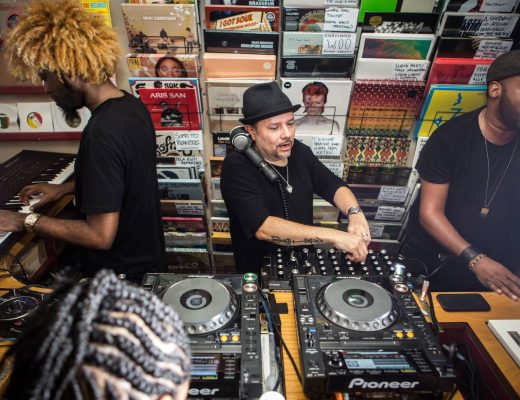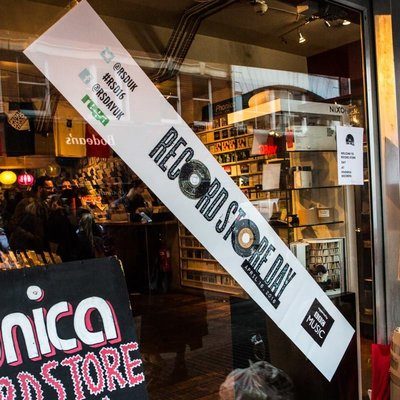
Last week saw Phonica play host to an in-store show with classically-trained electronic composer, Michal Turtle. After producing much of his music in the eighties, he returned to the scene when Dutch label, Music From Memory, unearthed and reissued a selection of his old material that was created whilst he was still a young man living with his parents in Croydon. The majority of this early work was born out of experimental studio sessions, incorporating jazz and ambient influences, whilst also drawing on Turtles’ own classical training. Seeing these tracks performed live was a magical moment for all involved.
We caught up with Michal after the show – check out his insights below and take a look at our (admittedly rather hazy) footage from the event.
Hi Michal, hope you’re well. How did the collaboration with Music From Memory come about? Were you surprised to have been approached with the idea to reissue your early work?
About 10 years ago people started emailing me and asking if I had any copies of my 1983 album, Music From the Living Room. I did, and was able to sell the last few that I had. Jamie from Music From Memory was somebody who wrote me in 2014, and after selling him one of my last copies he asked me if I’d ever thought of reissuing the album. We talked and I sent him a whole bunch of stuff from that time. After meeting the team in Amsterdam the 12-inch was pressed, and later the double album. I was surprised that anybody was interested enough to actually produce vinyl from stuff I had done so long ago, having produced and released lots of my own stuff in the intervening years.

I can understand why people of a certain mindset who may want a little bit more out of music would be completely bored by what is offered to them by the industry, and so would search for themselves to find what it is that clicks with them. There’s so much amazing stuff out there, and if you’re willing to explore rather than sit back and consume what is given to you, you will find your thing. I never made music with the goal of selling it to this or that market. I just did the stuff, and as a result it came out the way it did. That’s it. I like listening to it, and if somebody else does too, I’m happy. If nobody else does, I’m still happy.
You studied at the Royal Academy of Music in London and have played with the Royal Philharmonic Orchestra. How did this environment affect and inspire you as an artist?
I grew up in an environment filled with jazz records and started playing jazz drums at 8. My father thought it would be a good idea to develop the classical side a bit, so he got me enrolled on various music courses. I seemed to take to this world and ended up studying music. Luckily, at music college they’d just bought an 8-track studio, and I ended up using it for early test projects. I was always writing and playing some sort of strange, musically-twisted boogie. I still have the mixes, but I wouldn’t want to inflict them on anyone. After this, I was hooked and got myself a Portastudio as soon as possible. My classical studies seemed to run parallel to the recordings I did, but somehow I don’t see them as overly classically influenced. They were more just experimenting with whatever instruments were around, and the recording medium itself. My classical training has helped me tons over the years in arranging and writing, especially with the more commercial work I’ve done.

What were the main components of your home studio at the time of recording the tracks released on Phantoms of Dreamland?
Compared to what we have today, technically it was the Iron Age. The 4-track Portastudio was the recording medium, using audio cassettes running at double speed. My very first recordings were done on a Crumar DS2, but I bought some cheap and wonderful drum machines – the Dr. Rhythm DR55 and the Soundmaster SR88 I think they were called. I had a Vibraphone, Glockenspiel and lots of hand percussion. Later, I bought a bass guitar and an ARP 2600, and finally went polyphonic with a Juno 60. There are various other things on these recordings, usually borrowed electric pianos and a clavinet, whatever I could get my hands on.
You have worked on music and jingles for a number of TV and radio projects. How does your approach to creativity in this field differ?
Here, the classical training is very useful. I have done string arrangements on the computer that were later played by real players, so it has to work. You usually get between half a day and a full day, so there’s no room for mistakes – you have to know what is playable. Basically, I stay formulaic and not too complicated but still try to be fresh and creative, although very often it’s not what the client needs or wants. You have to listen to and take in what other people are saying – you’re never doing this alone.
What projects are you currently working on? Can we look forward to a live show featuring those songs written so long ago?
I have an ongoing project of my own (awawawa.ch) which is about writing for and working with kids on music – you can see a full explanation of how it works on the website. In terms of my own stuff, I’m producing mainly for the Swiss market, but I have produced 3 albums for English composer Jonathan FeBland, and 5 CDs with my own – now defunct – band Weraedust. Of course, much of my time is now taken up with the live version of Michael Turtle and we hope to be gigging from early next year!
Thanks Michal, it’s been an honour to have you!




